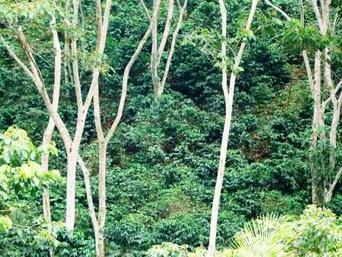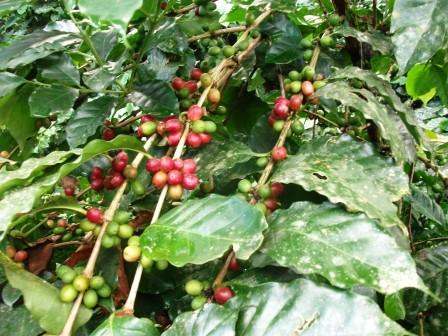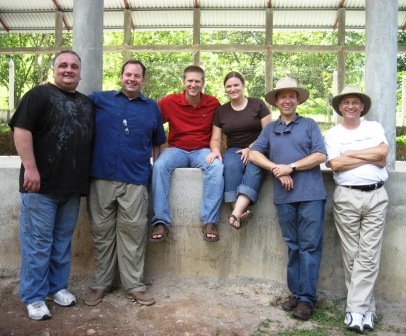|
We now have three future milking cows living in the mahogany plantation with our sheep. With our 2010 Gift Catalog that we had up during the holiday season, people seemed quite excited about our dairy project. So, with the funds that came in for the dairy we decided it was time to add cows to our land. Thanks to all who gave towards our dairy project!
For significantly less than the price of a full-grown, good milker, we were able to purchase three cows that are a year-and-a-half old. They will be ready for milking in about another year. Since we’re not ready for gallons of milk every day at this point, we figured this would be the most cost effective way to go. One interesting thing we’ve just learned is that cows supposedly make good shepherds. They are supposed to have a calming effect on a flock of sheep. Right now the sheep that we have are a bit wild and unused to being around people. They are quite literally very jumpy (who ever thought counting sheep jumping over a fence could be literal?). The cows had their wild and crazy time too though, as our guys worked to get them to the mahogany field.
0 Comments
Also this year, we finished our Activity Center, bought cows, bought sheep, and bought beehives. In our REWIND we also talk about our plans to start a Children's ministry for young people in surrounding villages. We've got lots going on. Thanks for helping us be here and make a difference in the lives of vulnerable young people. Click below to visit the site.
Getting sheep is one of our big goals for the next few weeks. We've been fencing in part of our mahogany fields for their grazing and building thatched structures for shelter. This fence has been a BIG project that's taken a lot more time and resources than we foresaw. We are excited though to go and find the first sheep to purchase.
In the next month we are also hoping to put up a chicken coop and start a flock of chickens for eggs, as well as getting our first beehives. Dialogue Church was kind enough to donate money for beehives in the spring. So far though, we have been unable to coordinate a time where we can travel to buy the beehives in a different part of Honduras and be able to get an expert to come teach us what we need to know.

We've also been working on putting up our new greenhouse. The goal is for this building to be a training center as well as place to start young plants. Right now the structure is up and we're ready to attach the shade cloth. We've already started a training program though, even without the finished facilities. A couple of our fall volunteers are doing an agricultural training program for a group of graduating 6th graders from our elementary school. We're trying to plant seeds of change in these young minds, teaching them about erosion prevention, crop diversification, and other important topics. Unfortunately with the way the soil is deteriorating in our area, the next generation will not be able to support their families by just growing beans and corn. We hope that by teaching the kids that we can help our area move into a successful future in agriculture.
We are excited to have such a strong group of visionary leaders behind us and we appreciate the time they gave to come and walk our property with their own two feet.
The main obstacle to realizing this goal is that in the past it has been difficult for people to obtain government permits to cut the wood they've grown. Several months ago, we became aware of a new move in Honduras to give incentives to people who have planted tropical hardwood trees, now that people are committing themselves to reforestation. We jumped on the opportunity and joined a USAID program which provides free permits to a limited number of hardwood plantations that are already underway. This will save our ministry thousands of dollars and means that we can grow with our trees into future self-sustainability.
We often struggle with how long we’ve waited for the government's permission to take in children and this reminds us to look at the great number of positive things happening as a result of our ministry. In the past couple of years we've made big strides in the construction and development of our facility, which will propel us into a great future. Already we’re touching the lives of the children in our community, through the classes we teach in our local school, as well as our weekly library activities. And, as you can see in the above photo, our two-year-old trees are growing tall and strong. Some are already 14' tall and have a 6" diameter and speak of the great future to come.
 Well, we didn't anticipate how much we would get into agriculture when we moved to Honduras, but so it is. We think that we can grow great food for kids and that this will help us provide for them and be partially self-sustaining. We think that this will be a great environment for kids to grow up in, where they learn the value of hard work and methods of providing for themselves in the future. Where we live, agriculture is how nearly everyone makes a living. We heard some wise advice recently that we've taken to heart: the world survives through agriculture and so we shouldn't be just trying to give people other careers and moving them into the cities. What they need are methods and specialization to be farmers that aren't poor farmers. So, we want to invest in agricultural projects to help our community and to teach the children we care for, while educating them, opening their horizons, and giving them options for their lives. Poverty is a lack of options.  So, enough theory. We have planted 10 acres of mahogany in the past year and we have more mahogany and teak starts growing. We have two acres of coffee that produce well and we are considering planting more. We have an acre of bananas and plantains that should start producing in about six months. The plan is to see which varieties of bananas and plantains do best for us, so we can plant more of that type. We planted several hundred fruit trees last year, of various types, and we have about 130 more fruit tree seedlings that we recently grafted. The cashew trees we started have done extremely well and we have about 100 to plant. Recently we tried some Asian vegetables in the garden and they did really well, so we're hoping to do some more experimenting in this department, as we continue learning about vegetable gardening in the tropics. The newest project has been researching vanilla. We had about 20 vanilla vines planted and then Jason discovered that we have a small island in our river just about covered with vanilla. We're hoping it's the same variety, so we can make our very own vanilla bean ice cream and of course have beans to sell. But the tricky thing with vanilla is that it only flowers like 2-3 days a year and you have to be out there to hand pollinate it when it does.
 One poor tree behind our house is so heavy with mangoes that it's branches are breaking off. Four branches fell in less than a day, so we put in supports for a couple of the remaining branches, in hopes that they'll hold on. The bucket in the photo was about half of what we gathered from the fallen branches. We're hoping they ripen up well. We love mangoes! |
Archives
December 2021
Categories
All
|
Give Hope... Make a Difference
|
|
Give Hope 2 Kids is a US 501-c3 non-profit. We are a non-denominational, Christian ministry. All donations are tax exempt to the full extent of the law.












 RSS Feed
RSS Feed